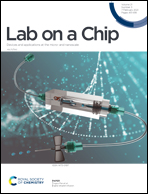Nanoporous silk films with capillary action and size-exclusion capacity for sensitive glucose determination in whole blood†
Abstract
In optical biosensing, silk fibroin (SF) appears as a promising alternative where other materials, such as paper, find limitations. Besides its excellent optical properties and unmet capacity to stabilize biomacromolecules, SF in test strips exhibits additional functions, i.e. capillary pumping activity of 1.5 mm s−1, capacity to filter blood cells thanks to its small, but tuneable, porosity and enhanced biosensing sensitivity. The bulk functionalization of SF with the enzymes glucose oxidase and peroxidase and the mediator ABTS produces colourless and transparent SF films that respond to blood glucose increasing 2.5 times the sensitivity of conventional ABTS-based assays. This enhanced sensitivity results from the formation of SF–ABTS complexes, where SF becomes part of the bioassay. Additionally, SF films triple the durability of most stable cellulose-based sensors. Although demonstrated for glucose, SF microfluidic test strips may incorporate other optical bioassays, e.g. immunoassays, with the aim of transferring them from central laboratories to the place of patient's care.



 Please wait while we load your content...
Please wait while we load your content...